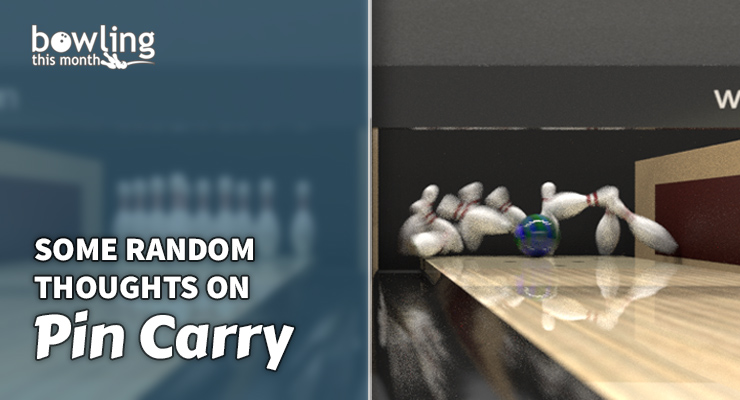Pin carry is an important topic to bowlers. Whether or not all the pins fall consistently on pocket shots can have a huge impact on a bowler’s scoring pace. A couple of corner pins left at the wrong time can easily turn your great game into a mediocre score.
Perhaps even worse than that, pin carry often seems extremely unfair. Whether it’s a pocket 7-10 split left at an inopportune time, or an opponent’s messenger 10 that leads to your defeat, bad pin carry can sometimes leave you feeling angry, confused, and downright victimized!
A lot can be said about pin carry, and so much already has been said. Many dozens of Bowling This Month articles have already discussed pin carry in at least some capacity, and they contain loads of great advice to help you understand what the pins are doing and how to make them fall when they aren’t cooperating—things like watching how your ball deflects and leaves the pin deck, how proper ball motion contributes to effective pin carry, what adjustments might be appropriate to improve your carry in certain situations, etc. If I’d stumbled upon all of this kind of information 20+ years ago when I first started learning to bowl, I could have saved myself years of confusion!
All of that said, though—and with nothing but the utmost respect for the many great authors, coaches, and technical experts who have weighed in on this topic before me—there are certain things about how pin carry is described that just…bother me. It’s not so much that I completely disagree with these certain things on a practical level; it’s more that I just don’t always agree with how they are described. And that’s the primary reason I decided to write this article: consider it a loose collection of semi-random—and sometimes wildly meandering—thoughts related to pin carry. I’ll admit that what you’re about to read is far from being the most practical resource out there on this topic, but I do hope that it at least gives you some things to think about and perhaps clears up some confusion on certain carry-related concepts.
As a quick caveat before we begin, I want mention that a lot of what I’m sharing below are my opinions. They are educated opinions (at least, that’s what I like to think of them as!), but they are still largely just opinions at this point, as I haven’t yet done rigorous scientific experiments to prove most of these views. These are just things that I currently believe, based on several decades of study and observation in this sport. If nothing else, perhaps this article will at least get you thinking about pin carry from a little bit of a different perspective, which I hope might lead you to better decision-making on the lanes and, ultimately, higher scores.
Anyway, let’s go ahead and get started. We’ve got a lot of ground to cover.
What leads to effective pin carry?
At first glance, pin carry is very complex. We’ve all heard the adage that when round objects are colliding with other round objects, sometimes the results can be unpredictable. Add to that the fact that it all happens so quickly—if you blink when your ball hits the headpin, you might miss everything—and it is easy to see why pin carry is often seen as random and unpredictable.
But, all of this complexity aside, pin carry is quite predictable in many ways. There are certain things that consistently cause the pins to fall much more reliably. To carry effectively, a bowling ball needs to be thrown with as many of the following attributes as possible:
- high speed,
- high rev rate,
- large entry angle,
- optimal pocket entry position, and
- high ball weight.
That’s pretty much it! Simple, right?
The strongest predictor of pin carry, in my opinion, is pocket entry position. This is the one that can trump all the others. A ball that hits extremely high flush in the pocket will strike almost every time, regardless of its speed, rev rate, entry angle, and weight (within reason, of course).
The problem is that no one can hit extremely high flush in the pocket every single time. That’s where the other factors listed above come into play. If you have insufficient entry angle, for example, the portion of the pocket that will result in strikes can become extremely small. But, if you add in lots of ball speed and rev rate, not-so-high-flush hits with not-so-much entry angle ...
This article is only available to Bowling This Month subscribers. Click below to get instant access to this article and all of our other premium instructional content.
Subscribe to Bowling This Month
Already a Bowling This Month subscriber? Click here to log in.
